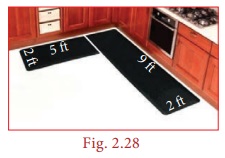Questions with Answers, Solution | Measurements | Chapter 2 | 8th Maths - Perimeter and Area of Combined shapes - Example solved problems | 8th Maths : Chapter 2 : Measurements
Chapter: 8th Maths : Chapter 2 : Measurements
Perimeter and Area of Combined shapes - Example solved problems
Example 2.5
Find the
perimeter and area of the given Fig.2.23. (π = 22/7)

Solution:
Radius of
a circular quadrant, r = 3.5 cm and side of a square, a = 3.5 cm.
The given
figure is formed by the joining of 4 quadrants of a circle with each side of a square.
The boundary of the given figure consists of 4 arcs and 4 radii.
(i) Perimeter
of the given combined shape
= 4 ×
length of the arcs of the quadrant of a circle + 4 ×
radius

= 22 + 14
= 36 cm (approximately)
(ii) Area
of the given combined shape
= area of
the square + 4 × area of the quadrants of the circle

A = 12.25+38.5 = 50.75 cm2 (approximately)
Example 2.6
Nishanth
has a key-chain which is in the form of an equilateral triangle and a semicircle
attached to a square of side 5 cm as
shown in the Fig. 2.24. Find its area. ( π
=
3.14, √3 = 1.732)

Solution:
Side of the
square = 5 cm
Diameter
of the semi-circle = 5 cm ⇒ Radius = 2.5 cm
Side of the
equilateral triangle = 5 cm
∴
Area of the key-chain = area of the semi circle + area of the square + area of the
equilateral triangle

= 9.81+
25 +
10.83
= 45.64 cm2 (approximately)
Example 2.7
A 3-fold
invitation card is given with measures as in the Fig. 2.25. Find its area.

Solution:
Figures I and II are trapeziums separately as well as combinedly.
The parallel sides of the combined trapezium (I and II) are 5 cm and 16 cm and its height, h = 8 + 8 = 16cm , length of the rectangle (III) = 16 cm and its breadth = 8 cm
Area of the combined invitation card = area of the combined trapezium + area of the rectangle
= 1/2 ×h×(a +b)+ l ×b

= 1/2×16×(5 +16)+16×8
= 168 +
128 =
296 cm2
Aliter:
Area of the
invitation card = area of the outer rectangle – area of the right angled triangle
= [l ×b] –
[ 1/2 ×b×h ]
= [ 24×16
] –
[ 1/2 ×11×16
]
= 384 − 88 = 296 cm2

Example 2.8
Seenu wants
to buy a floor mat for his kitchen at home as given in Fig. 2.27. If the cost of
the mat is ₹ 20 per square foot, what will be the cost of the entire mat?

Solution:
The mat given
in the figure can be split into two rectangles as follows:
Area of the
entire mat = area of the I rectangle + area of the II rectangle
= l1 ×b1 + l2 ×b2
= 5 ×2
+
9 ×2
=
10 +18
=28
sq.feet
Cost per
sq. foot = ₹ 20

The total cost of the entire mat = 28 × ₹ 20 = ₹ 560
Try these
In the above example split the given mat into two trapeziums and
verify your answer.
Solution:
Area of the mat = Area of I trapezium + Area of II trapezium
= [ 1/2 × h1 × (a1 + b1
)] + [ 1/2 × h2 × (a2 + b2
)] sq. units
= [ 1/2 × 2 × (7 + 5)] + 1/2
× 2 × (9 + 7) sq. feet
= 12 + 16 = 28 sq.feet
∴ Cost per sq.feet = ₹ 20
Cost for 28 sq. feet = ₹20
× 28 = ₹560
∴ Total cost for the entire mat = ₹560
Both the answers are the same.
Example 2.9
Find the
area of the shaded region in the square of side 10 cm as given in the Fig. 2.29. (π = 22/7)

Solution:
Mark the
unshaded parts of the given figure as I, II, III and IV
Area of the I and III parts = Area of the square – Area of 2 semicircles

= 10×10
–
22/7 ×5×5
= 100 – 78.57 = 21.43 cm2.
Similarly,
the area of the II and IV parts = 21.43 cm2
Area of the
unshaded parts (I, II, III and IV)
= 21.43 ×2
= 42.86 cm2 (approximately)
Area of the
shaded part = area of the square – area of the unshaded parts
= 100 – 42.86 = 57.14 cm2 (approximately)
Do you Know:
1. The area of the unshaded regions in each of the squares of side
a units are the same in all the cases
given below.

2. If the biggest circle is cut from a square of side ‘a’ units,
then the remaining area in the square is approximately 3/14 a2 sq.units. ( π = 22/7)
3. The area of the biggest circle cut out from the square of ‘a’
units = 11/14 a2 sq. units (approximately)
4. In the given figure if π = 22/7 , the area of the
unshaded part of a square of side a units
is approximately 3/7 a2 sq.units and that of the shaded part is approximately
4/7 a2 sq.units.

Example 2.10
Find the
area of an irregular polygon field whose measures are as given in the Fig. 2.30.

Solution:
The given
field has four triangles (I, III, IV and V) and a trapezium (II).

∴ The total area of the field = 15 + 65
+ 16 + 65 + 65 = 226 m2
Related Topics